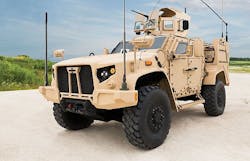Army orders 6,107 JLTV combat vehicles with open-systems vetronics in $1.7 billion deal
WARREN, Mich. – Armored combat vehicles designers at Oshkosh Defense LLC in Oshkosh, Wis., are building 6,107 new Joint Light Tactical Vehicle (JLTV) systems under terms of a $1.7 billion order announced this week.
Officials of the U.S. Army Contracting Command in Warren, Mich., are asking Oshkosh to build the 6,107 new JLTVs, as well as 22,166 installed and packaged kits. The order marks the tenth order under the contract that was awarded to Oshkosh in August 2015.
The Oshkosh JLTV is a light utility and combat multi-role vehicle that is expected to deliver a level of protection similar to that of current, but far heavier and less maneuverable, Mine Resistant Ambush Protected (MRAP) class designs, and much better than the latest armored HMMWV combat vehicles.
The JLTV is a version of the Oshkosh Light Combat Tactical All-Terrain Vehicle (L-ATV). The U.S. Department of Defense (DOD) wants to buy 54,599 JLTVs -- 49,099 for the U.S. Army and 5,500 for the U.S. Marine Corps. To date, Oshkosh has delivered more than 2,600 vehicles.
Related: Army, Oshkosh explore new capabilities for JLTV
Oshkosh officials say they expect a full-rate production (FRP) decision from the Army next month, followed by first Army unit equipped in early 2019.
story continues below
The JLTV features a vetronics architecture that complies with the Army's VICTORY electronics standard. VICTORY stands for Vehicular Integration for C4ISR/EW Interoperability. C4ISR/EW stands for command, control, communications, computers, intelligence, surveillance and reconnaissance/electronic warfare.
The JLTV's VICTORY compliant modular, scalable, open-architecture vetronics is designed to support "rapidly evolving C4ISR suites,” says George Mansfield, vice president and general manager of joint programs at Oshkosh Defense.
“This provides our soldiers and marines a vehicle that is capable of serving as a mobile command center," Mansfield says. "Today, other vehicles with this level of C4ISR capability are much larger, with little mobility.”
Related: Oshkosh prevails over AM General and Lockheed Martin to build JLTV armored combat vehicle
The U.S. Government Accountability Office (GAO) estimates that the DOD will spend more than $53.3 billion on the JLTV program -- $1.1 billion for research and at least $52.3 billion for procurement.
The JLTV has two variants -- a two seat and a four seat variant, as well as a companion trailer (JLTV-T). The Oshkosh vehicle offers the Core1080 crew protection for survivability, turret operated systems, remote weapons systems, and tube-launched missile system.
The Oshkosh JLTV features the company's TAK-4i intelligent independent suspension system that adjusts ride-height type with as much as 20 inches of wheel travel. The vehicle also has the digitally controlled General Motors Duramax V8 cylinder 6.6-liter diesel engine.
Related: Marines developing JLTV air-defense system armed with laser weapon
The vehicle can accommodate light, medium, and heavy machine guns, automatic grenade launchers, smoke grenade launchers, or anti-tank missiles, operated from ring mounts or a remote weapon station.
The JLTV contract has eight options for Oshkosh to build the first 16,901 vehicles for the Army and Marine Corps. The contract was awarded on behalf of the Army Tank-automotive and Armaments Command (TACOM) in Warren, Mich.
On this order Oshkosh will do the work in Oshkosh, Wis., and should be finished by September 2019. For more information contact Oshkosh Defense online at https://oshkoshdefense.com, the Army Contracting Command-Warren at https://acc.army.mil/contractingcenters/acc-wrn, or Army TACOM at www.tacom.army.mil.
Ready to make a purchase? Search the Military & Aerospace Electronics Buyer's Guide for companies, new products, press releases, and videos

